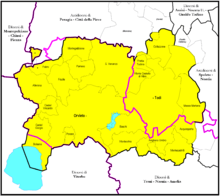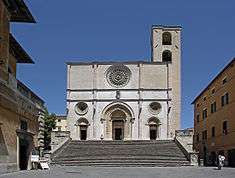Roman Catholic Diocese of Orvieto-Todi
| Diocese of Orvieto-Todi Dioecesis Urbevetana-Tudertina | |
|---|---|
|
Orvieto Cathedral | |
| Location | |
| Country | Italy |
| Ecclesiastical province | Immediately subject to the Holy See |
| Statistics | |
| Area | 1,200 km2 (460 sq mi) |
| Population - Total - Catholics |
(as of 2004) 90,800 89,500 (98.6%) |
| Parishes | 95 |
| Information | |
| Denomination | Catholic Church |
| Rite | Roman Rite |
| Established | 6th century |
| Cathedral | Basilica Cattedrale di S. Maria Assunta (Orvieto) |
| Co-cathedral | Basilica Concattedrale di S. Maria Annunziata (Todi) |
| Current leadership | |
| Pope | Francis |
| Bishop | Benedetto Tuzia |
| Emeritus Bishops | Giovanni Scanavino, O.S.A. |
| Map | |
 | |
| Website | |
| www.webdiocesi.chiesacattolica.it | |

The Italian Catholic Diocese of Orvieto-Todi (Latin: Dioecesis Urbevetana-Tudertina), in central Italy, was created in 1986 when the historical Diocese of Orvieto was united to the Diocese of Todi. This diocese is directly subject to the Holy See.[1][2] The current bishop is Benedetto Tuzia.
History
During the Gothic War, Orvieto was defended by the Goths for a long time. Later, it fell into the hands of the Lombards (606). From the latter end of the tenth century the city was governed by consuls, who, however, took the oath of fealty to the bishop; but from 1201 it governed itself through a podestà (in that year, the Bishop Richard) and a captain of the people. On account of its position, Orvieto was often chosen by the popes as a place of refuge and Pope Adrian IV fortified it.
The first known Bishop of Orvieto was John (about 590), and in 591 appears a Bishop Candidus; among its other prelates were Constantino Medici, O.P., sent by Pope Alexander IV in 1255 to Greece, where he died; Francesco Monaldeschi (1280), who did much for the construction of the cathedral. In 1528 Pope Clement VII sought refuge at Orvieto, after the sack of Rome, and while there ordered the construction of the "Pozzo di San Patrizio" (the well of St. Patrick), by Sangallo. Bishop Sebastiano Vanzi (1562) distinguished himself at the Council of Trent and built the seminary, which was enlarged afterwards by Cardinal Fausto Polo (1645) and by Giacomo Silvestri, who gave to it the college and other property of the Jesuits (1773); Cardinal Paolo Antamori (1780) caused the history of the cathedral of Orvieto to be written by Guglielmo della Valle; and lastly G. B. Lambruschini (1807).
Ordinaries
Diocese of Orvieto
Erected: 6th Century
- Corrado Caracciolo (1409 - 15 Feb 1411 Died)
- ...
- Giovanni Castiglione (bishop) (de Polena) (21 Oct 1454 - 1 Sep 1456 Died)[3]
- Marco Marinoni (1 Jun 1457 - 1465 Died)
- Giorgio della Rovere (1476 - )
- Ercole Baglioni (14 Oct 1511 - 1519 Died)
- Niccolò Ridolfi (24 Aug 1520 - 3 Sep 1529 Resigned)
- Vincenzo Durante (3 Sep 1529 - 4 Dec 1545 Died)
- Niccolò di Lorenzo Rodolfi (16 May 1548 - 1554 Died)
- Girolamo Simoncelli (25 Jun 1554 - 1562 Resigned)
- Sebastiano Vanzi (17 Apr 1562 - 1570 Died)
- Girolamo Simoncelli ( 1570 - 24 Feb 1605 Died)
- Giacomo Sannesio (20 Jun 1605 - 19 Feb 1621 Died)
- Pier Paolo Crescenzi (17 Mar 1621 - 23 May 1644 Resigned)
- Faustus Poli (23 May 1644 - 7 Oct 1653 Died)
- Giuseppe della Corgna (Cornea), O.P. (20 Mar 1656 - 23 Feb 1676 Resigned)
- Bernardino Rocci (24 Feb 1676 - 2 Nov 1680 Died)
- Savo Millini (Savio Mellini) (22 Dec 1681 - 17 May 1694 Appointed, Archbishop (Personal Title) of Nepi e Sutri)
- Giovanni Giuseppe Camuzzi (24 Jan 1695 - Sep 1695 Died)
- Vincentius degl'Atti (2 Jan 1696 - Nov 1715 Died)
- Ferdinando Nuzzi (30 Mar 1716 - 1 Dec 1717 Died)
- Onofrio Elisei (10 Sep 1721 - 27 Nov 1733 Died)
- Giuseppe di Marsciano (20 Jan 1734 - 2 Jul 1754 Died)
- Giacinto Silvestri (22 Jul 1754 - 12 Apr 1762 Died)
- Antonio Ripanti (14 Jun 1762 - 16 Mar 1780 Died)
- Paolo Francesco Antamori (11 Dec 1780 - 4 Dec 1795 Died)
- Cesare Brancadoro (11 Aug 1800 - 11 Jul 1803 Appointed, Archbishop of Fermo)
- Giovanni Battista Lambruschini (3 Aug 1807 - 24 Nov 1825 Died)
- Antonio Domenico Gamberini (19 Dec 1825 - 13 Apr 1833 Resigned)
- Antonio Francesco Orioli, O.F.M. Conv. (15 Apr 1833 - 18 Dec 1841 Resigned)
- Giuseppe Maria Vespignani (24 Jan 1842 - 2 Feb 1865 Died)
- Marino Marini (27 Mar 1865 - 15 Oct 1871 Resigned)
- Antonio Briganti (27 Oct 1871 - 2 Oct 1882 Resigned)
- Eusebio Magner, O.F.M. Cap. (25 Sep 1882 - 15 Aug 1884 Died)
- Giuseppe Ingami (10 Nov 1884 - 14 Aug 1889 Died)
- Domenico Bucchi-Accica (30 Dec 1889 - 7 Jan 1905 Died)
- Salvatore Fratocchi (24 Jan 1905 - 6 Dec 1941 Died)
- Francesco Pieri (6 Dec 1941 Succeeded - 15 May 1961 Died)
- Virginio Dondeo (22 Jul 1961 - 6 Aug 1974 Died)
- Decio Lucio Grandoni (12 Dec 1974 - 8 Nov 2003 Retired)
Diocese of Orvieto-Todi
30 September 1986: United with the Diocese of Todi to form the Diocese of Orvieto-Todi
- Giovanni Scanavino, O.S.A. (8 Nov 2003 - 5 Mar 2011 Resigned)
- Benedetto Tuzia (31 May 2012 - )
Notes
- ↑ "Diocese of Orvieto-Todi" Catholic-Hierarchy.org. David M. Cheney. Retrieved February 29, 2016
- ↑ "Diocese of Orvieto–Todi" GCatholic.org. Gabriel Chow. Retrieved February 29, 2016
- ↑ "Bishop Giovanni Castiglione (de Polena)" Catholic-Hierarchy.org. David M. Cheney. Retrieved April 30, 2016
External links
![]() This article incorporates text from a publication now in the public domain: Herbermann, Charles, ed. (1913). "article name needed". Catholic Encyclopedia. New York: Robert Appleton.
This article incorporates text from a publication now in the public domain: Herbermann, Charles, ed. (1913). "article name needed". Catholic Encyclopedia. New York: Robert Appleton.